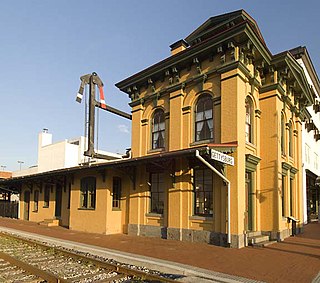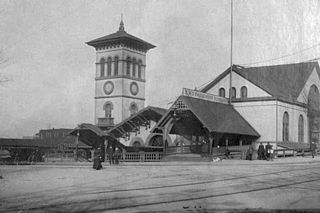
The Baltimore and Ohio Railroad was the first common carrier railroad and the oldest railroad in the United States with its first section opening in 1830. Merchants from Baltimore, which had benefited to some extent from the construction of the National Road early in the century, wanted to do business with settlers crossing the Appalachian Mountains. The railroad faced competition from several existing and proposed enterprises, including the Albany-Schenectady Turnpike, built in 1797, the Erie Canal, which opened in 1825, and the Chesapeake and Ohio Canal.

Baltimore Penn Station, formally named Baltimore Pennsylvania Station in full, is the main inter-city passenger rail hub in Baltimore, Maryland. Designed by New York City architect Kenneth MacKenzie Murchison (1872–1938), it was constructed in 1911 in the Beaux-Arts style of architecture for the Pennsylvania Railroad. It is located at 1515 N. Charles Street, about a mile and a half north of downtown and the Inner Harbor, between the Mount Vernon neighborhood to the south, and Station North to the north. Originally called Union Station because it served the Pennsylvania Railroad and Western Maryland Railway, it was renamed to match other Pennsylvania Stations in 1928.

The Philadelphia, Wilmington and Baltimore Railroad (PW&B) was an American railroad that operated independently from 1836 to 1881. Headquartered in Philadelphia, it was greatly enlarged in 1838 by the merger of four state-chartered railroads in three Mid-Atlantic states to create a single line between Philadelphia and Baltimore.

The Northern Central Railway (NCRY) was a Class I Railroad in the United States connecting Baltimore, Maryland, with Sunbury, Pennsylvania, along the Susquehanna River. Completed in 1858, the line came under the control of the Pennsylvania Railroad (PRR) in 1861, when the PRR acquired a controlling interest in the Northern Central's stock to compete with the rival Baltimore and Ohio Railroad (B&O).

U.S. Route 1 (US 1) is the easternmost and longest of the major north–south routes of the older 1920s era United States Numbered Highway System, running from Key West, Florida, to Fort Kent, Maine. In the U.S. state of Maryland, it runs 81 miles (130 km) from the Washington, D.C. line to the Pennsylvania state line near the town of Rising Sun.

The President Street Station in Baltimore, Maryland, is a former train station and railroad terminal. Built in 1849 and opened in February 1850, the station saw some of the earliest bloodshed of the American Civil War (1861-1865), and was an important rail link during the conflict. It is the oldest surviving big-city railroad terminal in the United States.

George Proctor Kane was an American politician and policeman. He is best known for his role as Marshal of Police during the Baltimore riot of 1861 and his subsequent imprisonment at Fort McHenry and Fort Warren without the benefit of habeas corpus. His position as Marshal of Police and his southern sympathies were two of many factors in Abraham Lincoln's decision in February 1861 to pass through Baltimore surreptitiously on his way to Washington to be inaugurated, in order to avoid a possible assassination attempt. Despite his politics, Kane was instrumental in providing protection and an escort for Mary Todd Lincoln on her arrival in Baltimore in February 1861 on her way to the inauguration of her husband, who had preceded her.

Camden Station, now also referred to as Camden Street Station, Camden Yards, and formally as the Transportation Center at Camden Yards, is a train station at the intersection of South Howard and West Camden Streets in Baltimore, Maryland, adjacent to Oriole Park at Camden Yards, behind the B&O Warehouse. It is served by MARC commuter rail service and local Light Rail trains.
The Baltimore Plot were alleged conspiracies in February 1861 to assassinate President-elect Abraham Lincoln during a whistle-stop tour en route to his inauguration. Allan Pinkerton, founder of the Pinkerton National Detective Agency, played a key role by managing Lincoln's security throughout the journey. Though scholars debate whether or not the threat was real, Lincoln and his advisors clearly believed that there was a threat and took actions to ensure his safe passage through Baltimore, Maryland. He ultimately arrived secretly in Washington, D.C., on February 23, 1861.

The Mount Royal Station is a historic building in Baltimore, Maryland, which was the Baltimore and Ohio Railroad's third train station in Baltimore, Maryland, and is now part of the Maryland Institute College of Art (MICA) campus. The station was at the north end of the Baltimore Belt Line's Howard Street tunnel in the Bolton Hill neighborhood. It was the first railroad station in the world to have electrified passenger trains when it opened on September 1, 1896, serving the B&O's famed Royal Blue line. Following its closure as a railroad station in 1961, it became part of the Maryland Institute College of Art, where it now houses the Middendorf Gallery, as well as studio and classroom space for the university's sculpture and fiber departments.

The Gettysburg Lincoln Railroad Station, also known as the "Gettysburg Train Station," "Lincoln Train Station" or "Western Maryland Railroad Station," is a historic train station with depot, platform, museum and offices on Carlisle Street in Gettysburg, Pennsylvania. Operable from 1858 to 1942, it contributes to the Gettysburg Battlefield Historic District and is most notable as President Abraham Lincoln's point of arrival on November 18, 1863 and departure, following delivery of the Gettysburg Address. The station served as both a hospital during the battle and hub for outgoing wounded soldiers and incoming resources and supplies following the end of the war. On 2015, following several years of delays, the station, which was originally owned by the Borough of Gettysburg but was bought by the Gettysburg Foundation, the non-profit partner to the National Park Service, was placed under the purview of the National Park Service.

Hanover Junction is a small unincorporated community, which is located in south-central York County, Pennsylvania, United States, near the borough of Seven Valleys. The junction serves as a rest stop on the York County Heritage Rail Trail.

James Crawford Neilson, or J. Crawford Neilson, was a Baltimore, Maryland-based architect. He was born in Baltimore, Maryland in 1816. After the death of his father in 1822 the family moved to England and in 1824 to Brussels. In 1833, he returned to Baltimore and in 1835, became a member of the survey party working on the Baltimore and Port Deposit Railroad,. His supervisor was Benjamin Henry Latrobe, II, (1806-1878), later supervising engineer on the Baltimore and Ohio Railroad,, son of an equally famous architect, Benjamin Henry Latrobe, (1764-1820). It was at this time that he first became acquainted with John Rudolph Niernsee, (1814-1885), while helping to survey in the area of Martinsburg, Virginia, for the Baltimore and Ohio Railroad.

The Washington, Baltimore and Annapolis Electric Railway (WB&A) was an American railroad of central Maryland and Washington, D.C., built in the 19th and 20th century. The WB&A absorbed two older railroads, the Annapolis and Elk Ridge Railroad and the Baltimore & Annapolis Short Line, and added its own electric streetcar line between Baltimore and Washington. It was built by a group of Cleveland, Ohio, electric railway entrepreneurs to serve as a high-speed, showpiece line using the most advanced technology of the time. It served Washington, Baltimore, and Annapolis, Maryland, for 27 years before the "Great Depression" and the rise of the automobile forced an end to passenger service during the economic pressures of the 1930s "Depression" southwest to Washington from Baltimore & west from Annapolis in 1935. Only the Baltimore & Annapolis portion between the state's largest city and its state capital continued to operate electric rail cars for another two decades, replaced by a bus service during the late 1950s into 1968. Today, parts of the right-of-way are used for the light rail line, rail trail for hiking - biking trails, and roads through Anne Arundel County.

The Gettysburg Railroad was a railway line in Pennsylvania that operated from 1858 to 1870 over the 17-mile (27 km) main line from the terminus in Gettysburg to the 1849 Hanover Junction. After becoming the Susquehanna, Gettysburg & Potomac Railway line in 1870, the tracks between Gettysburg and Hanover Junction became part of the Hanover Junction, Hanover and Gettysburg Railroad in 1874, the Baltimore and Harrisburg Railway in 1886, and the Western Maryland Railway in 1917.

The Baltimore Terminal Subdivision is a railroad line owned and operated by CSX Transportation in the U.S. state of Maryland. The line runs from Baltimore to Halethorpe along the original Baltimore and Ohio Railroad (B&O) line, one of the oldest rail lines in the United States and the first passenger railroad line. At its east (north) end, it connects with the Philadelphia Subdivision; its west (south) end has a junction with the Capital Subdivision and the Old Main Line Subdivision.

The Philadelphia and Baltimore Central Railroad (P&BC) was a railroad that operated in Pennsylvania and Maryland in the 19th and early 20th centuries. It operated a 110-mile (180 km) main line between West Philadelphia and Octoraro Junction, Maryland, plus several branch lines.

The Hanover Junction Railroad Station is an historic railroad station which is located in Hanover Junction in North Codorus Township, York County, Pennsylvania.

The Washington Depot or New Jersey Avenue Station was a train station located in Northwest Washington, D.C., a block north of the Capitol. The train station was also called the B&O Depot as it was served by the Baltimore & Ohio Railroad. It operated from April 1851 until October 26, 1907, when Union Station commenced operation. During the American Civil War, the New Jersey Avenue Station was the major embarkation site for hundreds of thousands of Union troops. President Abraham Lincoln arrived there to be sworn in as President in 1861. It was from that station that his body along with his son "Willie" Lincoln began its long journey to his final resting place in Illinois after he was assassinated on April 14, 1865.
Lincoln Bush (1860–1940) was an American civil engineer and inventor, known for his work with railroads.

















